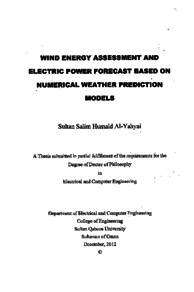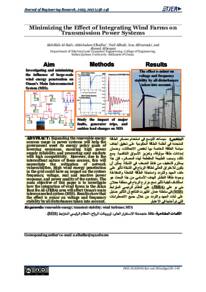Document
Wind energy assessment and electric power forecast based on numerical weather prediction models.
Publisher
Sultan Qaboos University
Gregorian
2012
Language
English
English abstract
Due to the intermittent nature of wind, wind resource assessment and electrical power forecast require an accurate wind data. Numerical Weather Prediction (NWP) models are used to generate the required data. Different parameters such as the initial state of the atmosphere and the boundary conditions play major roles in the quality of the generated wind data. Therefore, the provision of an accurate wind data presents a major challenge to wind energy market. This thesis aims to propose and develop approaches for better use of NWP models in wind energy applications. All proposed approaches were validated over the Sultanate of Oman. In resource assessment aspects, NWP nested ensemble approach was proposed to develop wind parameters database at high resolution (2.8km) and at different heights above the ground. Parameters include wind power density, wind speed frequency distribution, turbulence intensity and peak hour matching. Model validation results showed that the Bi-linearly interpolated ensemble mean performed better on average than each individual ensemble member. Using the generated wind parameters database, multi-criteria decision making technique was used for wind farm land suitability analyses. This technique was based on fuzzy logic using the aggregation operator extension (AHP-OWA combination) for wind resource assessment. This approach aims to select the best site for implementing wind farm projects. Based on the proposed approach, wind farm suitability maps for Oman were developed for different heights above the ground. Oman land suitability maps showed that the mostly suitable sites for wind farm installation are located on the area between Thumrait and Qayroon Hirity at Dhofar region and also located on the south eastern coast of Wusta region near Ras Madrakah and Ras Qarwaw. After selecting the best site for the wind farm, it is necessary to optimize the layout of the wind farm to maximize the energy production. Therefore, a geometrical approach for wind farm layout optimization was developed. This approach was used to determine the optimum orientation angle that will minimize the wake effect and hence maximize the capacity factor of the wind farm. It was demonstrated that the optimum angle used for orienting the vertical axis of aligned columns of the turbines relatively to the predominant-wind median axis should be around 18°. Selecting the best site doesn't guarantee continuous power generation from the wind farm. To assure an acceptable security of supply level and economical dispatch of the generated power, it is necessary to estimate in advance the expected power generation from the farm. It is also important to quantify the uncertainty of the generated power forecast. In this aspect, a spatial-temporal neighborhood approach for generating probabilistic wind and power prediction was proposed. This approach was used to convert the deterministic NWP model forecast to probabilistic forecast. In addition, this approach was used to quantify the uncertainty on the wind speed forecast. Validation results showed that spatial-temporal neighborhood approach was able to reduce the root mean square error by more than 50% compared to the deterministic approach over the validation sites
Member of
Resource URL
Arabic abstract
نظرا للطبيعة المتقطعة للرياح، تزداد الحاجة إلى بيانات رياح ذات مصداقية عالية خلال عمليات تقييم موارد الرياح لإختيار الأماكن الأنسب لبناء مشاريع طاقة الرياح. كذلك تزداد الحاجة لمثل هذه البيانات خلال عمليات التوقعات اليومية الطاقة التي يمكن إنتاجها من هذه المشاريع يتم استخدام نماذج التنبؤات العددية لإنتاج هذه البيانات. حيث يعتمد مستوى دقة التنبؤات العددية على الكثير من العوامل مثل البيانات الأولية لحالة الغلاف الجوي والبيانات الحدودية المنطقة الجغرافية التي يتم نمذجتها. لذلك فإن توفير بيانات رياح ذات دقة عالية يمثل تحديا كبيرا لسوق طاقة الرياح تهدف هذه الرسالة إلى اقتراح وتطوير وتدقيق طرق ومنهجيات من أجل تحسين استخدام نماذج التنبؤات العددية في تطبيقات طاقة الرياح. علما أن كافة الطرق والمنهجيات المقترحة تم تطبيقها والتحقق من مصداقيتها على بيانات خاصة بسلطنة عمان. فيما يتعلق بتقييم موارد طاقة الرياح، تم إقترح طريقة المجموعة المتداخلة لنماذج التنبؤات العددية. حيث تم استخدام هذه الطريقة لبناء قاعدة بيانات لعناصر الرياح ذات دقة عالية وبمستوى مسافات بينية يبلغ 2 . 8كم، وعلى ارتفاعات مختلفة عن مستوى سطح الأرض. قاعدة البيانات تشمل كل من كثافة طاقة الرياح ، توزيع ترددات سرعات الرياح، معامل شدة إضطرابات الرياح، ومطابقة سرعات الرياح بأوقات الذروة في استهلاك الطاقة أظهرت نتائج تقييم دقة مخرجات التنبؤات العددية أن متوسط سرعة الرياح المستخرجة من طريقة المجموعات المتداخلة أفضل من القيم المستخرجة من النماذج المستخدمة منفردة في نفس السياق تم استخدام تقنيات اتخاذ القرارات متعددة المعايير في تحليل مدى ملائمة الاراضي الإستخدامات مزارع الرياح. يستند هذا الأسلوب على المنطق الضبابي باستخدام معامل التجميع الحديث ( AHP - OWA combined )، يهدف هذا النهج إلى تحديد أفضل المواقع لتنفيذ مشاريع مزارع الرياح. استنادا إلى النهج المقترح، تم وضع خرائط ملائمة الأراضي الإستخدامات مزارع الرياح لسلطنة عمان وذلك على ارتفاعات مختلفة عن مستوى سطح الأرض. أظهرت هذه الخرائط أن أنسب المواقع تتركز في المنطقة الواقعة بين ثمريت وقيرون حيريتي في محافظة ظفار. كما يمكن ملاحظة مواقع مناسبة لمشاريع طاقة الرياح على الساحل الجنوب الشرقي للسلطنة بالقرب من راس مدركة ورأس قرواو. بعد اختيار أفضل المواقع التوليد طاقة الرياح، فإنه من الضروري إختيار الوضع الأنسب لتوزيع طواحين الهواء في الموقع وذلك لضمان إنتاج القدر الأعلى من الطاقة. في هذا المجال، تم تطوير طريقة هندسية لتحسين توزيع طواحين الهواء. تعتمد هذه الطريقة على تحديد زاوية الميل المثلى التي من شأنها تقليل التأثير السلبي لطواحين الهواء على بعضها البعض، وبالتالي زيادة قدرة توليد الطاقة من مزرعة الرياح. وقد تبين أن الزاوية المثلى لتوجيه المحور الرأسي لمزرعة طواحين الهواء عن وسيط محور الرياح السائدة يجب أن يكون °18 تقريبا. ونظرا للطبيعة الغير منتظمة من إنتاج طاقة الرياح، فإن دقة التنبؤ بسرعات الرياح يمثل تحديا كبيرا لمشغلي أنظمة الطاقة. فيما يتعلق بتوقعات الطاقة الكهربائية، تم تطوير طريقة تقوم بتحويل التنبؤات القطعية الناتجة من نماذج التنبؤات العددية إلى تنبؤات إحتمالية. كما تقوم هذه الطريقة بوصف مقدار عدم اليقين في تنبؤات سرعات الرياح وصفا كميا. تعتمد هذه الطريقة على استخدام توقعات الجوار المكاني والزماني لأحتساب إحتمالية حدوث مختلف فئات سرعات الرياح. وقد اظهرة نتائج تقييم الجودة بان التنبؤات الناتجة من استخدام طريقة الجوار المكاني والزماني استطاعت خفض معدل الخطأ بمقدار 50% مقارنة بالتنبؤات الناتجة من التنبؤات القطعية الناتجة من نماذج التنبؤات العددية.
Category
Theses and Dissertations


